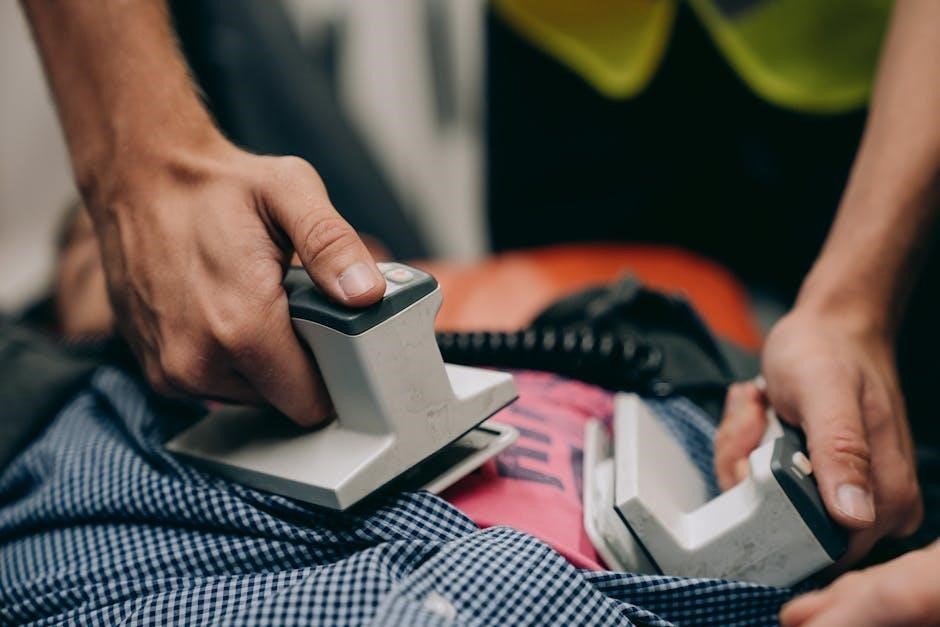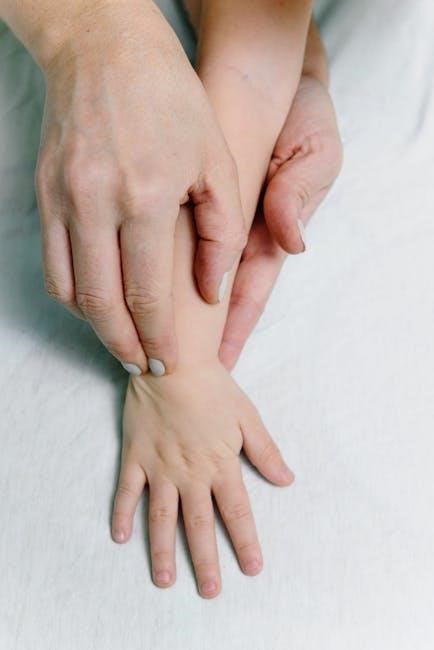What Is a Manual Defibrillator?
A manual defibrillator is a medical device delivering an electric shock to restore normal heart rhythm during cardiac arrest. It requires trained operation and is critical for infant emergencies.
Definition and Purpose
A manual defibrillator is a medical device that delivers controlled electrical shocks to restore normal heart rhythm during cardiac emergencies. Unlike automated models, it requires a trained operator to analyze heart rhythms and manually activate the shock. Its primary purpose is to treat life-threatening arrhythmias, such as ventricular fibrillation, in infants. Designed for precision, manual defibrillators allow for tailored energy doses, making them critical for pediatric care.
Types of Manual Defibrillators
Manual defibrillators designed for infants are specialized to deliver precise, pediatric-specific energy doses. They include portable models tailored for neonatal and pediatric intensive care units. Some devices offer adjustable settings to accommodate varying infant sizes and conditions. Certain models feature dual modes, allowing use for both infants and children. These defibrillators often come with pediatric-specific electrodes to ensure safe and effective operation. Choosing the right type requires consultation with healthcare professionals to match the device to the infant’s needs and ensure optimal care during emergencies.

Importance of Manual Defibrillators in Infant Care
Manual defibrillators are critical in infant care for restoring normal heart rhythm during cardiac arrest, preventing long-term damage, and improving survival rates in neonatal emergencies.
Role in Infant Cardiac Arrest
A manual defibrillator plays a vital role in infant cardiac arrest by delivering controlled electric shocks to restore a normal heartbeat. It is specifically designed for trained operators to apply precise energy doses, ensuring effective resuscitation. In emergencies, it helps halt irregular heart rhythms, preventing brain damage and death. The American Heart Association recommends a dose of 2 J/kg for infants, emphasizing the need for prompt intervention. Its use requires careful preparation and adherence to pediatric guidelines, making it indispensable in critical care settings for newborns and young patients.
Differences from Adult Defibrillators
Manual defibrillators for infants differ from adult versions by delivering lower energy doses, typically 2-4 J/kg, to accommodate smaller heart sizes. They use pediatric pads or electrodes designed for an infant’s chest, ensuring proper contact and safety. Unlike adult defibrillators, infant models often require manual adjustment of settings, emphasizing the need for trained operators. These adaptations ensure effective and safe defibrillation for newborns and young children, addressing their unique physiological needs during cardiac emergencies.

How to Use a Manual Defibrillator on an Infant
Turn on the device, prepare the infant by exposing their chest, and apply pediatric pads. Deliver a shock at 2-4 J/kg as recommended. Follow guidelines carefully.
Step-by-Step Instructions
Turn on the manual defibrillator and ensure it is set to infant mode. 2. Expose the infant’s chest and dry it if necessary. 3. Attach pediatric electrode pads to the chest as instructed. 4. Analyze the heart rhythm using the device. 5. If a shock is advised, charge the defibrillator. 6. Ensure no one is touching the infant. 7. Deliver the shock by pressing the discharge button. 8. Resume CPR immediately after the shock. Repeat if no return of spontaneous circulation.
Preparing the Infant for Defibrillation
Ensure the infant’s chest is dry and free from clothing or items that may interfere with electrode pads. Remove any metal objects or jewelry. Use pediatric electrode pads specifically designed for infants. Apply the pads according to the device’s instructions, typically with one on the upper left chest and the other on the back. Ensure the defibrillator is set to infant mode. This preparation ensures effective and safe defibrillation, maximizing the chances of restoring normal heart rhythm.

Safety Precautions When Using a Manual Defibrillator
Ensure the environment is safe, with no water contact. Use infant-specific pads to prevent burns. Keep the device away from pacemakers or other implanted medical devices.
General Safety Guidelines
Always ensure the environment is safe and dry before using a manual defibrillator. Avoid contact with water or metal objects. Keep the device away from MRI machines or high-frequency equipment. Never use it near individuals with pacemakers or implanted defibrillators. Ensure only trained personnel operate the device. Properly attach pads to avoid skin burns or improper shock delivery. Follow the manufacturer’s instructions for energy settings and pad placement. Regularly inspect the device and pads for damage or expiration. Store the defibrillator in a cool, dry place, out of reach of children.
Specific Safety Considerations for Infants
When using a manual defibrillator on infants, ensure infant-specific pads are used to prevent burns or improper energy delivery. The American Heart Association recommends a defibrillation dose of 2-4 Joules/kg for infants. Avoid placing pads on wet skin or near metal objects. Ensure the device is set to pediatric mode if available. Always follow the manufacturer’s guidelines for infant use. Keep the infant calm and still during the process. Consult pediatric resuscitation guidelines for precise energy settings and pad placement to minimize risks and ensure effective treatment.
Maintenance and Storage of a Manual Defibrillator
Regularly inspect pads, cables, and battery life. Store in a cool, dry place away from direct sunlight. Follow manufacturer guidelines for maintenance and updates.
Regular Checks and Maintenance
Regular checks ensure the manual defibrillator is functional. Inspect pads, cables, and battery life monthly. Replace expired or damaged components promptly. Follow the manufacturer’s maintenance schedule, including software updates. Store the device in a cool, dry place, away from direct sunlight and high humidity. Ensure the defibrillator is easily accessible for emergencies. Daily visual inspections and monthly operational tests are crucial. Keep a maintenance log to track checks and updates, ensuring readiness for infant emergencies.
Proper Storage Conditions
Store the manual defibrillator in a cool, dry place, avoiding direct sunlight and humidity. Keep it away from children and ensure it is easily accessible for emergencies. The device should be placed in its original case or a protective cover to prevent damage. Avoid extreme temperatures and exposure to moisture. Regularly check storage conditions to maintain functionality. Ensure the defibrillator is within reach for quick access during infant emergencies, adhering to manufacturer guidelines for optimal preservation and readiness.

Training and Certification for Using a Manual Defibrillator
Proper training and certification are essential for using a manual defibrillator on infants. Programs include hands-on practice and understanding of specific energy doses for infant use.
Recommended Training Programs
Recommended training programs for manual defibrillator use on infants include courses by the American Heart Association (AHA) and American Red Cross. These programs emphasize hands-on practice, recognition of cardiac arrest symptoms, and proper defibrillator operation. They cover infant-specific protocols, such as energy dose calculations and electrode placement. Certification ensures rescuers can confidently administer care in emergencies. These programs are designed for healthcare professionals and caregivers, focusing on practical skills to improve outcomes in infant cardiac arrest scenarios.
Certification Requirements
Certification for using a manual defibrillator on infants typically requires completing a training program accredited by organizations like the American Heart Association (AHA). These programs include both written and practical exams to ensure competency. Recertification is usually required every two years to maintain proficiency. Healthcare professionals and caregivers must meet these standards to legally and effectively operate manual defibrillators in emergency situations. Certification ensures proper device usage and adherence to infant-specific protocols, crucial for saving lives during cardiac arrest.
Limitations of Manual Defibrillators for Infants
Manual defibrillators for infants require skilled operation and may not always be immediately available, delaying treatment. Their effectiveness depends on correct dosage and pad placement, which can be challenging in emergencies. Additionally, these devices are heavier and less portable compared to automated options, making them less accessible in certain settings. Despite these limitations, they remain critical for infant cardiac arrest when properly used by trained individuals.
When Not to Use a Manual Defibrillator
- A manual defibrillator should not be used on infants with implanted pacemakers or defibrillators unless absolutely necessary and with caution.
- It should not be used by untrained individuals, as improper use can cause harm or delay effective treatment.
- Avoid using it in environments with high electromagnetic interference, as it may disrupt the device’s function.
- Do not use a manual defibrillator on infants who are not in a shockable rhythm, such as asystole or pulseless electrical activity.
- Consult specific guidelines for infants under one year, as manual defibrillators are preferred but require precise energy doses.
Challenges in Infant Defibrillation
Infant defibrillation presents unique challenges due to their small size and delicate physiology. Achieving the correct energy dosage is critical, as excessive shock levels can harm the infant. Proper pad placement and ensuring the device is specifically designed for infants are essential. Additionally, recognizing cardiac arrest in infants can be difficult, and delays in intervention worsen outcomes. Trained responders are crucial, as manual defibrillators require expertise to operate effectively in such fragile patients.
Manual defibrillators play a critical role in saving infants during cardiac emergencies. Their effectiveness hinges on proper training, correct usage, and immediate action. Understanding the unique challenges of infant defibrillation and adhering to safety guidelines ensures optimal outcomes. Regular maintenance and accessible storage of these devices are equally vital. By mastering the use of manual defibrillators, caregivers and healthcare professionals can significantly improve survival rates for infants experiencing cardiac arrest.